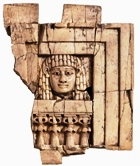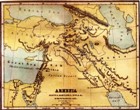Dan, northern city of ancient Israel
Bible Study: the conquest of Dan
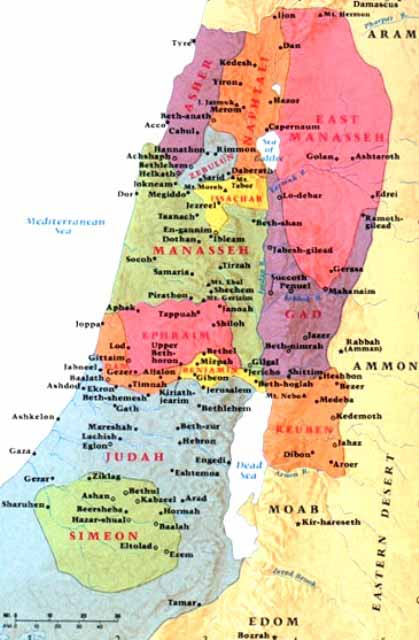
Territories allocated to the Twelve Tribes of Israel. Dan is in the far north.
When the twelve tribes of Israel entered the Promised Land, Joshua ‘gave’ each one a particular area. To the tribe of Dan he gave the fertile farmland around Timnah, up as far as Joppa.
In fact, the land was already occupied by Philistine troops, so his words were a promise, not a reality. Tough, battle-ready Philistines had already settled there. They were far too strong to let invaders take over their rich coastal territory (see an Egyptian carving of a helmeted Philistine captive below right).
These Philistines were one-time nomads of the sea who had decided to settle down. In many ways they were like the Vikings, who ravaged the coast of northwestern Europe and eventually settled there. As well as being tough, the Philistines had superior metal technology, and were careful not to allow the Hebrews access to it:
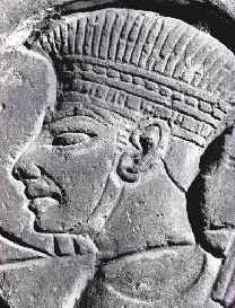
Stone carving of a Philistine warrior
‘No smith (a metalworker) was found in all the land of Israel, for the Philistines were afraid that the Hebrews would make swords or spears. So all Israelites had to go down to the Philistines to have their plow-shares, mattocks, axes, and sickles sharpened…. ‘ (1Samuel 13:19-22)
But the tribe of Dan had some tough men of their own – men who would not give up without a fight. They were experts at guerrilla warfare, the method used by fighters who are outnumbered and outgunned, as the Hebrews were.
One of them was Samson, whose astonishing strength and ingenuity helped him kill large numbers of Philistines – see The Story of Samson. Samson is a lot like Achilles in the ‘Iliad’ – his feud with the Philistines started with a dispute over a woman, just as Achilles’ with Agamemnon during the Trojan War. Some scholars have even suggested a connection between the tribe of Dan and the ‘Danaoi’, a name for Greeks in the ‘Iliad’.
But one strongman alone cannot win a war. Eventually the tribe of Dan faced the facts: it must give up its attempt to settle the Philistine heartland and look for an alternative place in the Upper Jordan Valley – where the pickings were easier.
Peaceful city brutally conquered
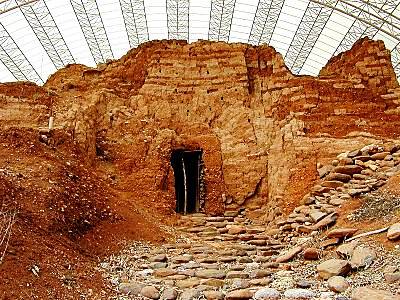
The mud-brick gateway at Dan, Middle Bronze Age
Unwelcome in Philistine territory, the tribe of Dan decided to upgrade. They trekked north and captured the established Canaanite city of Laish. The city had massive walls and ramparts so thick that houses were built inside. Its gates and walls (see right) had withstood many an assault.
It was an extraordinary coup. Dan was the most important city in the north, rich and plump as a bantam hen – it lay on the main trade route between Galilee and Damascus.
It also had special meaning for the Hebrews. Hundreds of years before, Abraham had come to the city to rescue his kidnapped nephew, Lot (Genesis 14:14).
The people of Laish did not give up their city without a fight, but it seems to have been fairly one-sided, and shows the ruthless nature of the tribe of Dan
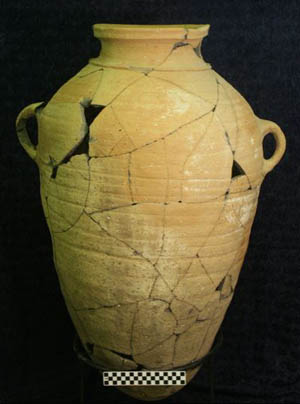
A collared-rim jar
‘…..they observed the people who were there living securely, after the manner of the Sidonians, quiet and unsuspecting, lacking nothing on earth, and possessing wealth. Furthermore, they were far from the Sidonians and had no dealing with Aram….’ (in other words, without any powerful allies).
‘The Danites…. came to Laish, to a people quiet and unsuspecting, put them to the sword, and burned down the city. There was no deliverer.’ (Judges 18:7, 27-28)
Ancient Pottery from Dan
The tribe of Dan brought its culture with it. Archaeological excavations show storage jars similar to jars in Galilee and Phoenicia, lying alongside typical ‘collared-rim’ jars from the central hill country – original home of the Danites.
The Danites did very nicely in their newly acquired city – so nicely, in fact, that they did not want to be bothered with trouble in the outside world – of which there was plenty.
The Promised Land – Who Got What
‘A Land of Milk and Honey’:
• milk, meaning there were good pastures for milk-producing animals like goats and sheep
• honey, meaning there were plenty of flowering plants, ie there was fertile land suitable for cultivation.
Who were the tribes? The original House of Joseph, described at the end of the Book of Genesis, was becoming divided into two groups named after his sons, Ephraim and Manasseh. Joshua’s task, given to him by Moses, was to find land for them.
The clans were already grouped together into more or less separate tribes. Gradually (not at once, since the ancient Song of Deborah names only ten tribes), these tribes split into ten, eleven, then twelve, named after Joseph, his full brother Benjamin (their mother was the beautiful but unhappy Rachel; and nine of his half-brothers:
• the sons of the homely but fertile Leah: Levi, Simeon, Reuben, Judah, Issachar and Zebulun
• the sons of the servant woman/concubine Bilhah: Dan and Naphtali
• and Gad and Asher, the sons of Zipah, also a serving woman/concubine.
A fruitful but complicated family.
The twelfth tribe would be the Tribe of Levi, the family group to which Moses belonged. It was a special priestly tribe excluded from the territorial distribution.
How they settled the Land
Despite the violence and drama of the Book of Joshua, the settlement of Israel was probably a gradual process. In Joshua 13:1, Yahweh comments, when Joshua is already old, that ‘much of the country remains to be occupied.’ In the words of the psalmist, ‘the people were few in the land, they wandered as strangers in the land of Canaan.’ (Psalm 105:12)
In contrast, the Bible tells a story of relentless warfare between the Israelites and hostile Canaanites whose land they were trying to take over. But much of this story may be due to later feelings of hostility between the two groups, as the priests of both groups battled for power.
Historians now think that the initial settlement was largely peaceful. Conflict was the exception rather than the rule.
Why do they think this?
First of all, the Israelite herdsmen moved into largely uninhabited or sparsely populated country.
Secondly, when they were among the settled plains dwellers, they seem often to have reached some sort of accommodation, and even begun to settle down themselves. The story of the rape of Dinah, in which the Israelite herdsmen slaughter the townspeople, was recorded because it was exceptional, and not the norm.
Who were the Philistines?
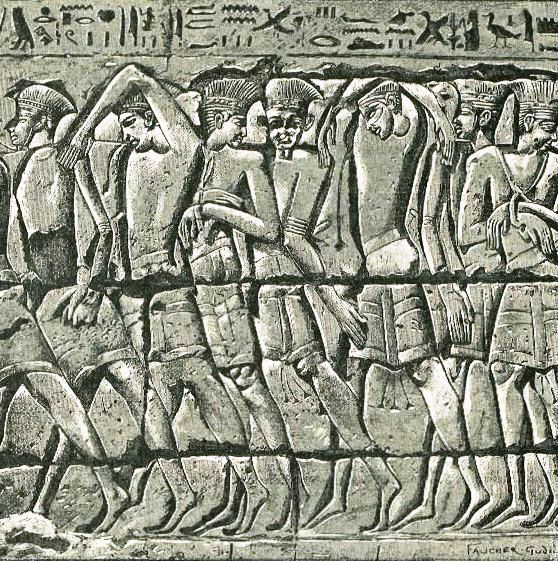
Philistine soldiers, captives of the Egyptians,
from a graphic wall relief at Medinet Habu
In about 1185-52BC, during the reign of Rameses III of the XXth Dynasty, Egypt and the countries at the eastern end of the Mediterranean were invaded in what Rameses called ‘the Great Land and Sea Raid’. We know this from the walls reliefs found at Medinet Habu. They tell the story, and it is not a pretty one (see the illustration of Philistine captives above).
Where did they come from?
The Philistines seem to have been a large group of marauding foreigners who had been displaced, possibly by invading forces, from their own region. These people had strong cultural links with the Mycenaeans, whose powerful city-states in Greece were suffering destruction at about this time. Homer’s story of the Trojan War is an echo of this violent period. Wherever they were form, the ‘Sea Peoples’ had come to stay.
Among them were the Philistines (Peleset). Depicted on the monumental frieze of Rameses III as tall, slim warriors wearing tasselled kilts and distinctive ribbed caps or helmets (see above), they possibly originated from Cyprus or Crete.
Some of the Sea Peoples, including the Philistines, settled in Canaan, mainly in the south coastal plain, a fertile strip forty miles long and fifteen or twenty miles deep.
There they founded five strong city-states. Three of these states, Ashkelon, Ashdod and Gaza, were beside the coastal road.
• Ashkelon possessed a harbour and enjoyed a prosperous trade.
• So also did Gaza, which seemed to have specialised in military resources.
• So did the fortress and commercial centre of Ashdod, three miles from the coast, which the Philistines had destroyed, but subsequently rebuilt.
• Another of the fortresses was Gath – a generic name meaning ‘wine-press’; it lay a litle further inland;
• so did the city of Ekron.
Philistine were traders, by sea and inland by caravans moving into the desert interior. Their wares were often transported in a new and distinctive form of pottery, which at first echoed the styles of Mycenaean Greek lands, and especially of Cyprus.
Why were the Philistines feared?
The Philistine cities were separate and independent, but when they were threatened their princes combined forces. They had a unified military command, with a well-armed and trained professional military class that was able to dominate the local Canaanites.
The army had exclusive use of iron, a newly discovered metal. The Bible tells us they denied blacksmiths and iron weapons and tools to the Israelites, as a way of keeping them in check.
Nevertheless, over the years the Philistines gradually assimilated with the Canaanites, and presumably intermarried with them as well; even their language was eventually replaced by a local Canaanite dialect.
Excavations at Ashdod have shown how many Canaanite elements became blended into Philistine culture. The gods of Aegean origin whom they had brought to the country adopted the names of Canaanite deities. These included
• Dagon, formerly a Mesopotamian deity, became their chief god, with Ashdod as his main centre
• Baal, worshipped at Ekron as Baalzebul, the prince (mockingly transformed by the Israelites into Baalzebub, Lord of the Flies)
• and the goddess Ashtoreth, fierce protectress of the family.
Despite this assimilation and apparent unity, the city-states of the Philistines became increasingly important independent military powers.
As time went on, their attempts to expand into the hill country inevitably involved them in open conflict with the Israelite tribes.
Samson and the Philistines
These hostilities are mirrored in the story of Samson, from the tribe of Dan, was forced by the Philistines to leave the foothills and migrate to its eventual home much further north.
Samson was said to have killed a thousand Philistines with the jawbone of an ass (an attempted explanation for the name Ramathlehi, ‘the hill of the jawbone’). But the sagas relating to his exploits also declared that he had a weakness for Philistine women, every one of whom proved treacherous. Here was a familiar moral concerning the danger of foreign females.
Finally he found himself trapped by the temptress Delilah, who cut off his hair, the source of his strength, while he slept.
Later, when he grew it again, he pulled down the whole temple of Dagon at Gaza, killing its occupants and himself. The photograph at right shows the Egyptian temple at Dendur – from another country and another period, but the double columns at the front of the building are similar to the ones described in the story of Samson’s death.
His long hair (like the sun’s rays?) has caused some scholars to regard him as a mythical figure etymologically related to the Canaanite sun-god Shemesh, whose shrine was in the centre of Dan’s original territory.
At all events, Samson became known as a boisterous, Herculean, folk-hero of fabulous strength and bawdy pranks. But he was probably a historical individual all the same: not perhaps, one of the judges, as the Bible regards him, but a tough resistance leader who made a name for himself.
He also earned admiration because he was one of the Nazirites (whose hair must not be cut). These were holy men set aside by their possession of ‘the spirit of Yahweh’ – ecstatic frenzy and ascetic abstinence. Originating from Canaanite fertility worships, the Nazirite movement was converted by the Israelites into an instrument designed to destroy those very cults, and the cults of other foreigners such as the Philistines.
Resistance warriors like Samson took the lead in whipping up the Israelites’ hatred of the Philistines, whose uncircumcised state made them alien. Israelite patrols attacked Philistine caravans coming in from the desert.
This was a foolish thing to do, since the Philistines had superior military organization and weapons. In about 1050BC the Philistines mustered their troops and confronted the Israelites, possibly all twelve tribes, at Ebenezer.
In the engagement that followed, the Israelites were rash enough to put their trust in a pitched battle, and suffered total defeat. After the disaster the Israelite elders sent for the Ark of Yahweh from Shiloh (which had fallen to the enemy), in order to raise the spirits of their shattered troops. If so, the measure proved ineffective, because a second crushing setback rapidly followed.
The Ark itself was captured by the enemy and taken to Ashdod.
It was a bitter lesson, but the Israelites learned to fight differently – to use guerilla warfare and surprise attacks. These worked far better for them than facing the Philistines in battle.
Detail of one of the Philistine captives
An Egyptian wall relief from the time of Rameses III
DAN’S WALLS AND GATES – STILL HERE
Partly excavated mud brick wall and gateway at Dan; Middle Bronze era
Excavated gateway at Dan
Building an ancient city
Nobody knows who invented bricks, but they certainly started something.
Brick-making is at least 6,000 years old. It was one of the first building materials, and is still a major player in the building industry.
How did people discover how to make bricks? Probably by picking up slabs of drought-dried mud (see right) and building a rough shelter from them. This could have happened in any one of the great rivers valleys that cradled civilization. It probably happened in all of them.
The technique of firing bricks to harden them was probably discovered accidentally, when bricks were used to surround a small fire.
Fired Bricks
The first bricks were simply shaped, sun-dried clay, but the brick kiln was quickly invented. Bricks used in Middle Eastern temples and ziggurats in the 3rd millenium BC – like the ziggurat of Ur – were fired in a kiln.
The Middle East was an ideal locale for mud brick buildings, since it had low humidity and rainfall.
The first archway of sun-dried brick was found in Ur, the ancient birthplace of Abraham and Sarah. The bricks for this arch would have been shaped and baked in about 4,000BC.
Of course, the trouble with sun-dried bricks is that they do not last – we only know about the archway mentioned above by a description of it.
HOW DID THEY LAST SO LONG?
The mud brick walls at Dan lasted for thousands of years, partly they were fired bricks but also because the walls and gateway at Dan were built over and accidentally preserved.
So for the modern visitor, the surprisingly small gateway is still visible – wide enough for a loaded donkey, but not much else, to pass through (see images at top of page).
Below: the Ziggurat of Ur, built of unfired and fired mud bricks
Ancient pottery and taxation
Ancient Jar with Collared Rim
Pottery has been found at Ur, home city of Abraham and Sarah, below the clay level called the Flood deposit. Immediately above this level, dating from about 3,000BC, wheel- made decorated pottery was found.
Earthenware pottery was made in Jericho as early as 4500BC.
Clay is the basic material of pottery. In its natural state it can be easily moulded, and when it is fired it hardens, becoming virtually indestructible – though not shatter-proof.
Clay, of course, was in abundance in the Middle East. In some areas, like Jericho, it was the only material available for building houses – there was no stone in the area.
The objects made from clay were usually useful in some way – for holding liquids, or as plates or bowls for food. They were used at all levels of society, with a rich variety of decoration.
Taxation is invented
Oddly enough, pottery was vital for the development of the organized city-state. Foodstuffs could only be collected in quantity if there was a way of storing the food, and large pottery containers provided this.
So rulers of tribes, city-states and eventually nations were able to collect food from the lower orders and store it – which was of course the beginning of the taxation system…
Large storage jar, Qumran, 1st century AD
Deborah & Barak: no show at Deborah’s battle
Dan: position, position…
The Danites settled into their rebuilt city and took up much the same way of life their predecessors had enjoyed. Removed from the other Israelite tribes, they integrated more and more into the surrounding culture.
The land was fertile, and they grew more food than they needed. So they traded with the seaports on the coast, quickly becoming a food basket for the whole coastal strip.
They journeyed back and forth in baggage trains on the road to the coast, with frequent contact with non-Israelite cities like Sidon and Tyre. Before long they began to emulate these sophisticated coastal cities – something the Bible writers did not like at all.
Meanwhile the other Hebrew tribes were locked in a struggle with the Canaanite city-states and the Philistines. They needed the people of Dan to help.
The Dan-ites wanted nothing more than to be left alone. They were doing good business, and did not want to rock the boat.
Cowardice or common sense?
Dan ignores Deborah
For this reason, when Deborah summoned the tribes to help her general Barak face the Canaanite general Sisera, the Danites ignored her summons.
Deborah was not impressed. Their failure to show at the battle where they were sorely needed is recorded in the Song of Deborah
‘… and Dan, why did he abide with the ships? (Judges 5:17) – the ships in this case being a nick-name for the Philistines in the coastal cities.
But worse was to come.
Where it happened: the plain beneath Mount Tabor
Trade in the ancient world
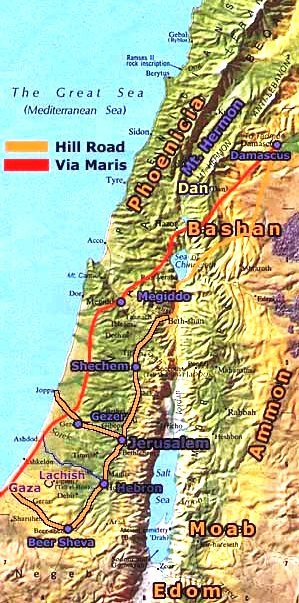
The main trade routes
in ancient Israel
Trade routes in ancient Israel
TRADE = MONEY = SUCCESS
Israel lay on two of the great trade routes of the ancient world, the King’s Highway and the Via Maris (Sea Road). These roads linked the two great superpowers of the time, Egypt and Mesopotamia. Lying across these roads, it was inevitable that Israel would become a trading nation.
By the time the Israelites arrived, a well-oiled trading system had already been created. Mules, and later camels, were used as beasts of burden to carry goods over long distances. Fodder for the animals was available along the route, making travel easier for the traders
The downside of Israel’s position was that it also lay on the path of armies from Egypt or Mesopotamia, when these countries attacked each other – which was often. Any invading army knew it was necessary to secure Israel before it moved on to it real target, and Israel often had to pay huge amounts to buy its safety.
Sometimes even money failed to keep Israel safe. Lachish, for example, was destroyed because it was too near Jerusalem, too much of a threat to the rear of Sennacherib’s army, whose real target was Egypt.
Dan as a bread-basket
Traders mostly used the trade routes for transporting luxury goods, but the city-state of Dan was fairly close to the coastal cities, and produced more food than it needed, so the area around Dan became a breadbasket.
It prospered – Dan could ask a good price for its food, and it did.
The downside as far as the biblical writers were concerned was that the people of Dan integrated rather too well with the coastal cities, who were not Jewish and who worshipped gods other than Yahweh.
Dan’s prosperity and its cosy relationship with foreigners were probably to blame for Dan’s refusal to answer Deborah’s summons, when she called the Danites to fight with the other Israelites against the Canaanite king at Mount Tabor.
Mount Tabor and the fertile land at its foot
DEBORAH AND BARAK GO TO BATTLE
Deborah’s Victory over Sisera
For the story of this battle, go to BIBLE WOMEN, DEBORAH
Why is this battle important to Dan?
After all, the city of Dan did not fight in it.
But as it happened, NOT fighting it was the important thing.
Almost all the other Israelites tribes took part in this great battle. Deborah, judge of Israel, had summoned them, and they had responded to her call.
The confrontation was like the classic David and Goliath story. Small, poorly equipped and trained Israelite soldiers stood up to the might of a technologically superior and disciplined Canaanite army.
A heavy iron wheeled chariot, from the wall reliefs at Nineveh
Chariots in battle
Against all odds, the Israelites won – by God’s intervention, or a gigantic stroke of luck, or both.
The Canaanite chariots hurtling across the plain on their fearsome iron wheels were stopped dead in their tracks by a sudden downpour. Bogged in the mud, sinking under their own weight, they were easy prey for the Israelite sling men and archers, who picked off the enemy soldiers one by one.
It was a rout, a great military triumph, just when the tribes were at a low point and needed reassurance that God was on their side. The Battle at Mount Tabor gave them this reassurance.
But the Danites had refused to help when Deborah summoned them. They not only missed out on the glory of the victory, but were branded as cowards as well.
And since the victory was such an unexpected triumph, it was celebrated again and again throughout Israel’s history, with Dan’s cowardice (or prudence?) mentioned every time.
The Danites had established a lasting reputation for themselves, and not a good one.
Where it happened: the plains at the foot of Mount Tabor
PAGAN SHRINE AT DAN
After the death of King Solomon, the country he had ruled was divided into two kingdoms, Israel in the north and Judah in the south.
King Jeroboam of Israel decided to set up administrative bases at the northern and southern extremities of his kingdom – and Dan became the northern capital. It also became a religious center, and this is what worried the Bible writers.
Sacred area at Dan
Jeroboam’s plan was to wean his subjects away from the glamour of Solomon’s Jerusalem Temple by reviving the sanctuaries at Bethel and Dan. This would mean expelling the priestly Levites who were loyal to Jerusalem, and replacing them with local priests.
The Bible says Jeroboam
‘made two golden calves and told the people: ‘You have gone up to Jerusalem for long enough. Here is thy God, Israel, who led thee up from the land of Egypt.’ (1 Kings 12:28)
THE GOLDEN CALF
Jeroboam’s Golden Calf was a wooden statue covered with gold plate – see similar statues at ANCIENT RELIGIONS
Originally, there was no confusion about what it was: the animal was not the god, only a symbol of it. The statue was merely a ‘house’ for the god.
The Golden Calf?
After all, the Temple of Jerusalem had the Ark, and the Cherubim above it formed the throne of Yahweh. Everyone knew the Ark was not God himself. So too with the Golden Calf: it was a throne for the invisible godhead who, as Jeroboam said, ‘led them up from the land of Egypt’.
But the choice of a bull, even as a ‘throne’ of the god, had its dangers. The bull was the symbol of the great Canaanite god Baal. Ordinary people were bound to confuse the bull of Yahweh and the bull of Baal, especially in a part of the country that depended on agricultural fertility, as the city of Dan did.
Maybe Jeroboam was aware of this, and tried to merge the two concepts of God. Maybe he wanted to cater to different religious groups by extending the notion of what God is. Instead, there was a resurgence of Canaanite religion, and worship of Yahweh was threatened.
Pagan Altar for Sacrifice
Nearly all archaeologists agree that this excavated podium was the one that Jeroboam built to house the Golden Calf at Dan. It is called a ‘bama’, a high place, and was a platform for altars and a shrine. There were other religious objects at Dan: three iron shovels used to remove ashes from the altar and an iron incense holder.
There were solid city gates to guard this sanctuary. The inner gate had four guard rooms, two on each side of a paved passageway. If you go to Dan and look carefully at the threshold stone, a massive slab of basalt, you will see the doorstop and hinge-sockets which once supported the great wooden doors.
The King-judge’s Throne/Seat of Honor
Just inside the gate were four squat, carved stones. These were probably used as the base for pillars supporting a canopy, a sort of open-air throne or seat of authority for a king or judge –
‘Then the king arose, and sat in the gate and they told all the people, saying behold, the king doth sit in the gate. And all the people came before the king’. (2 Samuel 19:8)
The wooden columns for this structure were smooth and polished, either stained or painted a bright color. The dais was covered by a roof, and there was an ornate seat where the judge/governor sat.
Click on the thumbnail (above right) to see an Egyptian version of this portable throne – admittedly much grander than the one in Dan, but with the same design and purpose.
Eventually, Dan fell on hard times. Its treasures were lost, its altars destroyed.
The ancient ‘horned altar’ at Dan
The High Place at Dan, mentioned in the Bible
Ancient temples usually stood on an acropolis, a word we usually associate with Athens. In fact, an acropolis is the stone platform that formed the base for all temples. The acropolis of the shrine at Dan is still visible today.
The Barmah or sacred area at Dan
The altar itself seems to have been a four-square stone platform with ‘horns’ at each corner. The reconstruction below is based on stones found at Beersheba, the southern city that also had a shrine to Baal and the gods and goddesses of Nature worship.
The purpose of the horns is unknown. If the animal was slaughtered on this altar, the horns might have been used to brace the ropes holding it down. But a slaughtered animal would generate quite a large amount of blood, certainly enough to put out the flames needed to burn the sacrifice. The animal must have been slaughtered at one side of the altar, rather than on it.
The horned altar was not confined to Israel and Canaan. The painting below shows its use in the Greek city of Corinth.
Greek artwork showing a sacrifice made at a ‘horned’ altar
Corinth, circa 540-530BC
The sacred area surrounding the altar always held a large water container, with which priests purified themselves before the ceremoney and cleansed themselves afterwards. In the Temple of Jerusalem this container was made of bronze, decorated with twelve brass oxen.
The water was not just functional: it was a link with Baal’s battle with Yam-Nahar, the destructive power of water. Oxen, symbols of power and fertility, were common victims for sacrifice. The idea behind sacrifice seems to have been that you gave the god the best you had, in the hope of pleasing it and finding favor.
Reconstruction of the Horned Altar, used at Dan
Excavated stones of the Horned Altar, showing their size
GODS AND GODDESSES
The Bull on Wall Street, New York – a Golden Calf? Who do you worship?
What is God? Who do you worship?
‘Worship’ is putting all your faith in something outside yourself, trusting it to bring you happiness. And trying to control how it will respond. A good part of the world today worships Money, and dedicates their life to acquiring it.
The people of ancient Israel were divided between two concepts of God, and two ways of worshipping.
The southerners, centered on Jerusalem, generally put their faith in Yahweh.
The northerners seem to a large extent to have preferred the ancient gods of fertility. A case in point was the city of Dan, criticised by the biblical writers for building an altar to the fertility gods.
Excavations of the ancient altar at Dan
The shrine at Dan
Why was it built?
• A shrine would be well patronized – there was a strong devotion in the northern cities to the fertility gods.
• It would cut out the need for northerners to make the long pilgrimage to Jerusalem.
• Money from taxes imposed on worshippers would stay in the north.
A shrine to the gods and goddesses of fertility would be popular with devout worshippers. It is relatively easy for a modern person to see God as a single being, but at the time Dan built its altar, the concept of Yahweh was revolutionary. This single spirit god, all powerful but without human characteristics and warmth, was meant to replace the family of gods who had ruled since time immemorial. He (it?) seemed remote and intangible to the common people.
Fertility gods
As far as ordinary people were concerned, the gods of fertility were all around, a daily experience. They were not remote or invisible, but here, now, part of normal life, in the earth and the air around you.
They were easy to identify with, since they reflected humanity. The gods and goddesses did all the things that people do. They had sex, got angry, fell in love, quarreled with their families, and generally expressed what was best and worst in human nature. Their stories made sense of the human experience – which is what religious stories are supposed to do.
The gods were woven into all the cycles of human life, particularly the cycle of life, death and rebirth. For farmers, this was an immediate issue, since each year they experienced the death of vegetation in winter and its resurrection in spring. Farmers needed to predict and possibly control this cycle, which could mean the difference between a good and a bad harvest.
It was this cycle that absorbed wroshippers of the fertility gods. They had a special devotion to Baal and Asherah, the gods who controlled the resurrection of Nature in springtime.
The Egyptian fertility goddess Hathor
Her counterpart in Israel was Anat
Controlling the weather
The worship of Asherah, Anat and Baal was especially important after the harvest, when the summer drought had baked the soil hard, and crops had to be replanted.
It was essential that the first rains of winter fall on the land, to soften the sun-baked soil for ploughing and sowing the new crop.
The priests of Yahweh instead promoted the idea of a single god who controlled everything, rather than a confederation of gods who acted out the tensions of human behavior and daily life. Unlike the fertility gods, who were inclined to live and let live when it came to other forms of worship, Yahweh reacted angrily if other gods were worshipped.
Phoenician image of a bull calf, representing vitality and fertility in Nature
Bestiality and the Bible
Neither side could understand the other, and the Jahwists became increasingly hostile to worship of Baal and Asherah. They associated Asherah’s image, the figure of a cow feeding her calf, with bestiality, a practice that certainly occurred in ancient Israel.
Bestiality involved having sex with an animal, usually a calf or heifer. Reliable sources say it is not difficult to do. You wait until the heifer is on heat, which happens every twenty-one days or so, and then stand behind her. As soon as she sense there is someone there, she becomes perfectly still, waiting to be mounted. In no time the deed is done. Kinsey’s Report says it is a relatively common practice in agricultural communities.
We know that it happened in biblical times because is specifically forbidden four times in the Bible (Leviticus 18:23, 20:15-16, Exodus 22:19, Deuteronomy 27:21).
Curiously enough, it may have been part of a religious ceremony practised by the ancient Canaanites. An Ugaritic myth tells of Anat, Baal’s sister, trying to find Baal, god of water in all its forms. He has died (there is a drought), but Anat eventually finds him. When he sees her he is overcome with love. He has intercourse with her in the form of a cow (Anat, like the Egyptian goddess Hathor, is often represented with the ears of a cow). Since no-one in ancient myths seems to have sexual intercourse without becoming pregnant, the myth ends with the announcement to Baal by Anat that “A wild ox is born to Baal, a buffalo to the Rider of the Clouds” (Baal).
Pink granite statue of the goddess Hathor, University of Sydney
Notice her ears, shaped like a cow’s
Religious tolerance
The official policy of the rulers of the northern kingdom of Israel, a multi-ethnic country, was to let each person worship as they wished. It was a brave effort, and in hindsight it was doomed to failure. There simply was no spirit of compromise around to make this ideal work.
Building a shrine/altar to the fertility gods in Dan was not simply a matter of personal choice for the king who did it. There was politics to think of. In the ancient world, any treaty between two countries involved paying respect to each other’s gods. It was only a formality, but a necessary one in the diplomatic world of the time. As in the Mafia, showing respect really meant something.
BAAL, ASHERAH, MOT AND ANAT
Statue of the god Baal
In his raised right hand he held a thunderbolt,
in his left a stylized bolt of lightning
The ancient gods of Canaan
The main fertility god in ancient Israel was BAAL, the god of water – rain, storms, river-water.
In the theology of Canaanite religion, Baal was divine semen that fell on the earth, penetrated it, and stimulated it to produce life. The earth might be female, but it needed Baal’s power to fertilize it. Without him, there was no life. Baal was water in all its forms; without him, the earth was parched and barren. His power was benevolent. He rode the clouds, sending lightning and thunder to show his power, but also dispensing the kindly rains in their season to make the earth fertile.
He was complemented by ASHERAH, the Earth, from which all life sprang. She was the Great Mother of plants, animals and humans. She had the gift of life within her, because she could produce new life from her own body.
When people thought of an image that summed up her qualities, they often saw her in animal form as a cow suckling her calf from great fat udders full of milk.
We still use the term ‘Mother Earth’, and ancient people venerated the earth as if it were their own mother. They saw in the curves and crevices of the earth something that reminded them of the body of a woman. In some countries they even painted the entrances of caves to look like the vulva of a woman.
Baal’s counterfoil was MOT, the god of Death in Nature. He was the summer heat which killed all vegetation, a necessary part of the cycle of life, but feared.
His power began to rise in late autumn, getting the better of Baal, so that water disappeared, vegetation wilted and died, and hunger stood ready to kill all humans, especially the weak and the sick. His image was a lion, ready to tear humanity apart.
Another deity, important to ordinary women, was ANAT, the daughter of Asherah. She was woman: young girl, married woman and matriarch. She protected and controlled everything to do with the household, producing a family then guarding its welfare fiercely. As brave as a lioness in the face of danger, she was ready to fight and kill in defense of her family.
This ancient ideal of womanhood was never yielding or submissive – quite the reverse, in fact. Anat could be quite terrifying. One of the Canaanite myths tell of the way she slaughtered Baal’s enemies then decorated herself with the heads and hands of the slain, wading in their blood up to her knees.
She was loyal to the men of her family if they needed her, and in fact the relationship between Anat and her brother Baal is one of the most enduring in ancient mythology. But Anat could bully and manipulate the men in her family if she judged it to be in their best interest. She was all softness when she loved, “as the heart of an antelope yearns for its fawn, so is the heart of Anat”, but she took her revenge on anyone who hurt her family. This was the model of womanhood that ancient Israelite women learnt about as children, and practised as women.
Phoenician statue of a bull calf, covered in gold leaf,
the Golden Calf of the Bible
The King-Judge – ancient law
Seat of Honor/Judgement at the gate of Dan
The king or governor of a city-state was responsible for administrating the laws. These laws were often spelt out for the populace on stone steles, so that anyone who was literate could read them. The Stele of Hammurabi, for example, detailed the laws of Hammurabi’s empire.
Like the Ten Commandments, Hammurabi’s Code was said to have come from a divine source, in this case Shamash the sun-god. It lists the laws first, then gives details of punishments for transgressions.
Like the Ten Commandments, the Code is not a complete system of law, but it covers a wide range of subjects, giving us an idea of the structure of society at the time.
THE DEATH PENALTY
The death penalty was common, used not only for such crimes as murder, rape and desertion in military service, but also for a wife’s flagrant extravagance or, a serious crime indeed, watering down beer.
Trial by ordeal was used, but only as a last resort, when both parties seemed to be lying under oath.
Justice was administered in public, for all to see. This was the reason for the Seat of Honor found at the gates of Dan. Here a governor or petty king heard cases and judged them, with due ceremony.
The illustration below is Egyptian. Though more lavish than the Seat of Honor would have been in a provincial city like Dan, it gives some idea of the structure that once stood on the four carved stones found at the entrance of Dan.
Egyptian ceremonial throne and canopy
The Code of Hammurabi
Hammurabi stands before the sun-god Shamash, receiving the laws
For more on the laws of ancient Israel, see ‘The Stone Tablets of Moses’
THE STELE OF DAN
The Stele of Dan
Fragments of a large basalt stele(an upright stone slab or pillar with inscription) from 858-824 BC were found in front of the city gate at Dan. The language on the stele is ancient Aramaic, and thirteen lines of the original inscription have been partly preserved. This is the Tel Dan Stele, and it is important in the study of biblical archaeology because it mentions the House of David.
It was created against a backdrop of war and violence. The 9th century BCE and the beginning of the 8th century BCE saw savage conflicts between the kings of Israel and the expanding kingdom of Aram-Damascus. (1 Kings 15:20)
Dan’s Entrance Gate
One of the Aramean kings of Damascus – we do not know which one – carved this stone to mark the capture of Dan. It was propaganda, recording a moment of sweet victory. Before the world of newspapers and mass media, this was how you let everyone know how lucky they were to have you as their king.
But the important thing for biblical scholars is that in lines 7-8 two kings of Israel and Judah are mentioned:
• Jehoram, king of Israel
• Ahaziah, king of Judah.
We know from the Bible that these two kings were allies. We also know they were defeated by Hazael, king of Aram-Damascus. (2 Kings 8:7-15, 28; 9:24-29). The Stele of Dan is concrete evidence to back up the Bible’s story.
The stele was found in fragments. Someone had deliberately smashed it to bits. This was probably Jehoash, king of Israel, who fought the Arameans three times and defeated them (2 Kings 13:25), recovering the city of Dan. Re-installed in Dan, he smashed the stele erected by his enemy Hazael.
The End of Dan
Tiglath Pileser III
When the fearsome Assyrian Tiglath-pileser III invaded in 732BC, Dan disappeared from sight.
The people who lived there probably suffered much the same fate as the people of Lachish – see LACHISH – THE BATTLE for images of the terrible fate of captives.
Those who survived were banished together with the other northern Israelites (II Kings 15:29). Where they went is unknown. The Assyrian kings at that time had a policy of assimilation, and the Danites became one of the Lost Tribes of Israel.
Go to BIBLE STUDY GUIDE for some interesting study ideas
The High Place of Dan, once sacred, now deserted
The stele of Dan: the house of David
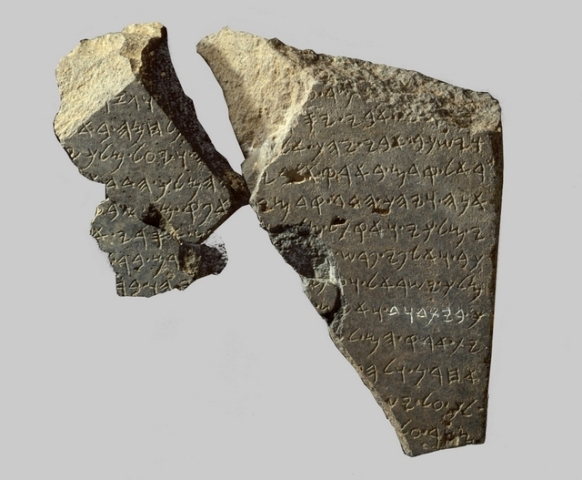
Early Aramaic inscription found in Dan, dating from 9th century BC. The text mentions the Battle of Ben Hadad, King of Aram against the ‘House of David’ – meaning one of the Kings of Israel. “And Ben-hadad hearkened unto king Asa, and sent the captains of his armies against the cities of Israel, and smote Ijon, and Dan, and Abel-beth-maacah, and all Chinneroth, with all the land of Naphtali.” I Kings 15:20
In the ancient world, steles were inscribed pillars giving information to passers-by. Most commonly, they were grave markers, but they were also used by kings for proclamations that could be read (by some) and known (by all)
The stele found at the gates of Dan contained a commemorative inscription. It has been translated thus:
1. […………………]…….[……………………………..] and cut […………………….]
2. [………] my father went up [against him when] he fought at[….]
3. And my father lay down, he went to his [fathers]. And the king of I[s-]
4. rael entered previously in my father’s land. [And] Hadad made me king.
5. And Hadad went in front of me, [and] I departed from [the] seven[…..]
6. of my kingdom, and I slew [seve]nty kin[gs], who harnessed thou[sands of cha-]
7. riots and thousands of horsemen (or: horses). [I killed Jeho]ram son of [Ahab]
8. king of Israel, and I killed [Ahaz]iahu son of [Jehoram kin]g
9. of the House of David. And I set [their towns into ruins and turned]
10. their land into [desolation……………………]
11. other …[………………………………………………………………. and Jehu ru-]
12. led over Is[rael…………………………………………………………….and I laid]
13. siege upon [……………………………………………………]
The interesting thing about the inscription is the phrase ‘the House of David’. This is possibly the first mention ever found outside the Bible of the House of David, and by inference King David, Israel’s great hero, though it has to be said that there is debate among scholars over whether the words really refer to King David of Jerusalem.
The Meshe Stele, recording the trials and victories of King Mesha of Moab
There is mention in it of King Omri of Israel,
father-in-law of the notorious Queen Jezebel
THE GATE AT DAN – WHAT HAPPENED?
The Iron Age gate complex at Dan
The Dan Inscription was discovered in the foreground area,
by the massive basalt gates leading up to the city.
Looking through the city gates at Dan
When a city was captured, its citizens were either killed gruesomely or taken into captivity, to be sold as slaves. Such would have been the fate of the people of Dan.
Before they were killed or taken away, the leading citizens of the city/state were ritually humiliated at the city gates, and items of significance were smashed in front of them, so that the would appreciate how powerless they now were.
This is probably how the Stele of Dan was broken into pieces, then left in the dust to be found by archaeologists many centuries later.
TIGLATH PILESER III AND ISRAEL
Wall relief showing Tiglath Pileser III
Tiglath-pileser III, who ascended the throne in 745BC, transformed Assyria into a world empire that ruthlessly and effectively ruled the ancient Middle East for a century. By a series of consecutive conquests, he conquered and annexed land reaching from central Syria to the borders of the Egyptian frontier.
Tiglath-piler’s Annals make one thing clear – he demanded heavy tribute from his subjects. The recorded list includes gold, silver, tin, iron, elephant hides, ivory, multi-colored garments, linen garments, wool dyed bluish-purple and reddish-purple, maple wood and boxwood, horses, mules, cattle and sheep, camels, and she-camels with their young.
A heavy blow was inflicted on Judah when Tiglath-pileser advanced with his army from northern Syria and passed along the Mediterranean coast from Phoenicia to Philistia. They advanced as far as Egypt, where Tiglath-pileser set up a stele to commemorate his victory and to mark this limit of his empire.
Among the kings listed on the stele who had to pay tribute was Ahaz, king of Judah. This was bad enough, but worse for ordinary people must have been the havoc wreaked by the passage of the vast Assyrian Army through Syria-Palestine.
Tiglath-pileser III’s genius was not only military. He also introduced a number of innovations, among them the process of mass deportation and resettlement. Selected residents, outstanding craftsmen and soldiers were taken from the newly conquered provinces and resettled in regions of Assyria. In place of these deportees, Aramean and Chaldean tribes from Babylonia were brought as colonists to the conquered areas. In this way the power of the conquered people was broken, because they were deprived of their elite, and the new colonists formed a hybrid culture that was predominantly loyal to Assyria.
Tiglath-pileses apparently annexed Galilee (and the city of Dan), which he conquered in 733-732BC. It became known as the province of Magiddu, with the city of Megiddo as its center.
Dan – Bible Study Guide
Here are some varied activities for a Bible Study Group
To fight – or not? for the ‘DEBORAH AND BARAK’ page
Deborah summoned the people of Dan to take part in a war they did not want to join. They refused to take part in fighting the Canaanites, enemies of the Hebrew people.
What responsibility do we have to fight in a war being fought by our country?
Spend some time thinking about this. What is your opinion? What reasons do you have to back this up? Now talk about this in a discussion group.
Worshipping False Gods – for the ‘PAGAN SHRINE’ page
The 1st Commandment forbids us to worship false gods: ‘Thou shalt not worship false gods before Me.’ But frequently we do.
What other gods do you worship?
• Money?
• Youthful looks?
• Your job?
• A perfect body?
See TOP TEN WAYS TO HELL for some ideas.
Now name your own particular false gods.
Imagine you want to wean yourself off these gods. How would you go about doing it? Can you? Is it possible?
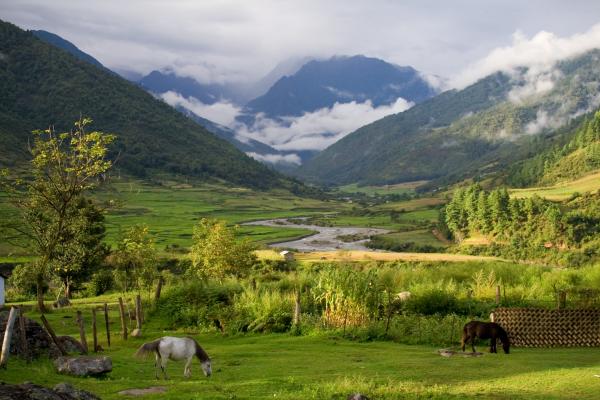
Idyllic landscape – the Promised Land?
The Promised Land
God told Moses that Dan was the northern limit of the ‘Promised Land’.
Work out a definition of your own ‘Promised Land’
• for yourself
• for all humanity
Jot down your ideas. Then rework them until you have a clear statement of what your ‘Promised Land’ would be.
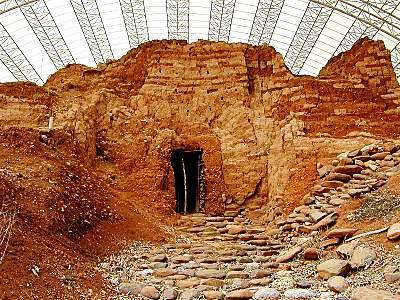
The mud brick walls and gateway of ancient Dan
Resources – Bible study groups
Abraham rescues his nephew Lot
for ‘BRUTAL CONQUEST’ page
When Abram heard that his nephew had been taken captive, he led forth his trained men, born in his house, three hundred eighteen of them, and went in pursuit as far as Dan.( Genesis 14:14)
God Shows Moses the Promised Land
Then Moses went up from the plains of Moab to Mount Nebo, to the top of Pisgah, which is opposite Jericho, and the Lord showed him the whole land: Gilead as far as Dan, all Naphtali, the land of Ephraim and Manasseh, all the land of Judah as far as the Western Sea….. (Deuteronomy 34:1-2)
Snorting Horses!
The snorting of their horses is heard from Dan; at the sound of the neighing of their stallions the whole land quakes. (Jeremiah 8:16)
Slaughter at Dan
for ‘BRUTAL CONQUEST’ page
1 In those days Israel had no king. And in those days the tribe of the Danites was seeking a place of their own where they might settle, because they had not yet come into an inheritance among the tribes of Israel.
2 So the Danites sent five of their leading men from Zorah and Eshtaol to spy out the land and explore it. These men represented all the Danites. They told them, “Go, explore the land.” So they entered the hill country of Ephraim and came to the house of Micah, where they spent the night.
3 When they were near Micah’s house, they recognized the voice of the young Levite; so they turned in there and asked him, “Who brought you here? What are you doing in this place? Why are you here?”
4 He told them what Micah had done for him, and said, “He has hired me and I am his priest.”
5 Then they said to him, “Please inquire of God to learn whether our journey will be successful.”
6 The priest answered them, “Go in peace. Your journey has the Lord’s approval.”
7 So the five men left and came to Laish, where they saw that the people were living in safety, like the Sidonians, unsuspecting and secure. And since their land lacked nothing, they were prosperous. Also, they lived a long way from the Sidonians and had no relationship with anyone else.
8 When they returned to Zorah and Eshtaol, the Danites asked them, “How did you find things?”
9 They answered, “Come on, let’s attack them! We have seen the land, and it is very good. Aren’t you going to do something? Don’t hesitate to go there and take it over.
10 When you get there, you will find an unsuspecting people and a spacious land that God has put into your hands, a land that lacks nothing whatever.”
11 Then six hundred men of the Danites, armed for battle, set out from Zorah and Eshtaol.
12 On their way they set up camp near Kiriath Jearim in Judah. This is why the place west of Kiriath Jearim is called Mahaneh Dan to this day.
13 From there they went on to the hill country of Ephraim and came to Micah’s house.
14 Then the five men who had spied out the land of Laish said to their fellow Danites, “Do you know that one of these houses has an ephod, some household gods and an image overlaid with silver? Now you know what to do.”
15 So they turned in there and went to the house of the young Levite at Micah’s place and greeted him.
16 The six hundred Danites, armed for battle, stood at the entrance of the gate.
17 The five men who had spied out the land went inside and took the idol, the ephod and the household gods while the priest and the six hundred armed men stood at the entrance of the gate.
18 When the five went into Micah’s house and took the idol, the ephod and the household gods, the priest said to them, “What are you doing?”
19 They answered him, “Be quiet! Don’t say a word. Come with us, and be our father and priest. Isn’t it better that you serve a tribe and clan in Israel as priest rather than just one man’s household?”
20 The priest was very pleased. He took the ephod, the household gods and the idol and went along with the people.
21 Putting their little children, their livestock and their possessions in front of them, they turned away and left.
22 When they had gone some distance from Micah’s house, the men who lived near Micah were called together and overtook the Danites.
23 As they shouted after them, the Danites turned and said to Micah, “What’s the matter with you that you called out your men to fight?”
24 He replied, “You took the gods I made, and my priest, and went away. What else do I have? How can you ask, ‘What’s the matter with you?’ ”
25 The Danites answered, “Don’t argue with us, or some of the men may get angry and attack you, and you and your family will lose your lives.”
26 So the Danites went their way, and Micah, seeing that they were too strong for him, turned around and went back home.
27 Then they took what Micah had made, and his priest, and went on to Laish, against a peaceful and unsuspecting people. They attacked them with the sword and burned down their city.
28 There was no one to rescue them because they lived a long way from Sidon and had no relationship with anyone else. The city was in a valley near Beth Rehob. The Danites rebuilt the city and settled there.
29 They named it Dan after their ancestor Dan, who was born to Israel—though the city used to be called Laish.
30 There the Danites set up for themselves the idol, and Jonathan son of Gershom, the son of Moses, and his sons were priests for the tribe of Dan until the time of the captivity of the land.
31 They continued to use the idol Micah had made, all the time the house of God was in Shiloh. (Judges 18)
The Golden Calf at Dan – for ‘PAGAN SHRINE’ page
‘So the king held consultations, and made two golden calves, and he said to them “It is too much for you to go up to Jerusalem; behold your gods, O Israel, that brought you up from the land of Egypt!” He set one in Bethel and the other he put in Dan. Now this thing became a sin, for the people went before the one as far as Dan. And he made houses of high places, and made priests from a certain part of the people who were not of the sons of Levi.’ (Kings 12:28-31)
Extra Bible References to Dan
The city of the tribe of Dan, called also Laish – Genesis 14:14
Captured by the people of Dan – Joshua 19:47-48
The city of the tribe of Dan – Judges 20:1
Dan captured by King Ben-hadad – 1 Kings 15:20
Ancient city of Dan – photo gallery
Iron Age city walls at ancient Dan
Land near the ancient city of Dan, with Mount Tabor in the distance
Aerial photograph of Mount Tabor
The Iron Age gate complex at Dan
The ancient gateway into the fortified city of Dan
The ‘place of honor’ by the gate at ancient Dan
The Bamah, or sacred place, at Dan
The ‘high place’ at Dan, view from behind the altar
Dan: a reconstruction of the Horned Altar
The partly excavated mudbrick gateway at Dan, from the Middle Bronze Age
Middle Bronze Age mudbrick gateway into Dan
Maps of Dan
The territory allocated by Joshua to the Twelve Tribes of Israel
The territory for Dan is marked in dark green,
and fronts onto the Mediterranean.
The city of Dan, on the other hand, is in
the top right corner of the territory allocated to Naphtali.
Map showing territory allocated to each of the Twelve Tribes of Israel
Trades routes in ancient Israel
Map showing events of the battle at Mount Tabor in which, conspicuously,
Dan played no part
Search Box
![]()
Bible Study Resource for Women in the Bible: Dan, short history of the city with Bible texts and activities
© Copyright 2006
Elizabeth Fletcher

